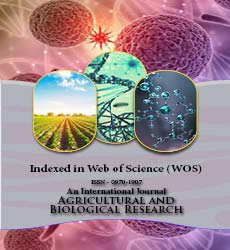Agricultural and Biological Research
RNI # 24/103/2012-R1
Zekarias Asale*, Elias Bojago and Krishna Moorthy
Cyanobacteria, a diverse group of photosynthetic microorganisms, have gained recognition for their potential contributions to agriculture and environmental hazard remediation. This critical review aims to comprehensively analyze the current understanding of cyanobacteria's role in these areas. In fact, cyanobacteria are available both in terrestrial and aquatic environments. In the realm of agriculture, cyanobacteria have shown promise in enhancing productivity through various mechanisms. Their ability to fix atmospheric nitrogen, solubilizing phosphorus, consortia formation etc. boosts soil fertility and downloads usable nutrients for plants. Additionally, cyanobacteria contribute to carbon sequestration by fixing carbon dioxide through photosynthesis, aiding in climate change mitigation. Cyanobacteria have enriched with carbohydrates, proteins, polyunsaturated fatty acids, vitamins and minerals, which avoid starvation, deficiency disease and exacerbation of poverty. The advantage of cyanobacteria bio fertilizers were environmental suitable, counter limitation, renewable and, reduce dependence on synthetic fertilizers. Moreover, the inoculation of cyanobacteria bio fertilizers in the soil improves soil fertility, nutrient availability and crop resilience to environmental stresses. Cyanobacteria also, play a significant role in soil aggregation, enhancing soil structure, water infiltration and nutrient retention. In environmental hazard remediation, cyanobacteria contribute to nutrient cycling by assimilating excess nitrogen and phosphorus, reducing the availability of these nutrients for Harmful Algal Blooms (HABs). Cyanobacteria can synthesize metalbinding proteins, which provide resistance to metal and other environmental stresses. The synthesis and secretion of bioactive compounds and biofilm formation helps, bind with heavy metals, agrochemicals, oil and other wastes enhanced the efficiency of waste remediation. This review aid for further research and technological advancements to harness their full potential. This review also discusses a feasible agricultural potential and ecological contribution of cyanobacteria. Overall, this critical review provides valuable insights into the potential of cyanobacteria in addressing agricultural and environmental challenges. It underscores the importance of understanding their role in sustainable practices and highlights the need for interdisciplinary approaches to maximize their benefits while minimizing potential risks.
